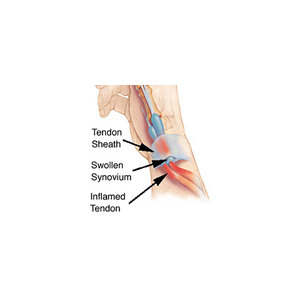Conditions of the Thumb
Thumb:
Your thumb is very different from your other four fingers. To begin with, the thumb only has two bones (or phalanges) while the other fingers have three. The thumb is also opposable, meaning its enhanced freedom of movement enables you to touch your thumb to the tips of your other four fingers, allowing you to grasp objects. A system of muscles makes all this movement possible, and repeated use of these muscles puts stress primarily on two joints – the Basal joint, located at the very base of the hand between the thumb and the wrist, and the Metacarpophalangeal (MCP) joint, located at the base of the thumb.
DeQuervain’s Tenosynovitis (also called DeQuervain’s Syndrome):The inflammation of tissue on the inside of the wrist. The inflammation causes swelling of the tendon sheath (lining) and synovium (a fluid-filled sac that lubricates the tendons) which pinches the tendons and makes them painful and unable to slide easily. Symptoms include pain, tenderness and possibly a small knot on the thumb side of the wrist.
Basal Joint Arthritis:Arthritis occurring at the Basal joint, often caused by repeated wear and tear on the joint. Arthritis is a disease that slowly destroys the cushioning cartilage surrounding the joint, permitting the bones to rub against one another, causing inflammation, nagging pain and stiffening. Pain is experienced during lifting, or activities such as turning a door handle or unscrewing a jar lid.
Skier’s Thumb: Involves an injury to the ligament at the MCP joint. It is one of the most common injuries to affect skiers, usually the result of a fall or direct impact, and results in significant thumb pain and possible joint instability.
Gamekeeper’s Thumb:Involves the hyperextension of the thumb at the MCP joint. This is a very common sports injury characterized by displaced and non-displaced tears of the attached ligament, usually the result of trying to break a backwards fall or jamming / stubbing the thumb.
Your thumb is very different from your other four fingers. To begin with, the thumb only has two bones (or phalanges) while the other fingers have three. The thumb is also opposable, meaning its enhanced freedom of movement enables you to touch your thumb to the tips of your other four fingers, allowing you to grasp objects. A system of muscles makes all this movement possible, and repeated use of these muscles puts stress primarily on two joints – the Basal joint, located at the very base of the hand between the thumb and the wrist, and the Metacarpophalangeal (MCP) joint, located at the base of the thumb.
DeQuervain’s Tenosynovitis (also called DeQuervain’s Syndrome):The inflammation of tissue on the inside of the wrist. The inflammation causes swelling of the tendon sheath (lining) and synovium (a fluid-filled sac that lubricates the tendons) which pinches the tendons and makes them painful and unable to slide easily. Symptoms include pain, tenderness and possibly a small knot on the thumb side of the wrist.
Basal Joint Arthritis:Arthritis occurring at the Basal joint, often caused by repeated wear and tear on the joint. Arthritis is a disease that slowly destroys the cushioning cartilage surrounding the joint, permitting the bones to rub against one another, causing inflammation, nagging pain and stiffening. Pain is experienced during lifting, or activities such as turning a door handle or unscrewing a jar lid.
Skier’s Thumb: Involves an injury to the ligament at the MCP joint. It is one of the most common injuries to affect skiers, usually the result of a fall or direct impact, and results in significant thumb pain and possible joint instability.
Gamekeeper’s Thumb:Involves the hyperextension of the thumb at the MCP joint. This is a very common sports injury characterized by displaced and non-displaced tears of the attached ligament, usually the result of trying to break a backwards fall or jamming / stubbing the thumb.



